2016 BMW 328D XDRIVE SEDAN sunroof
[x] Cancel search: sunroofPage 175 of 257
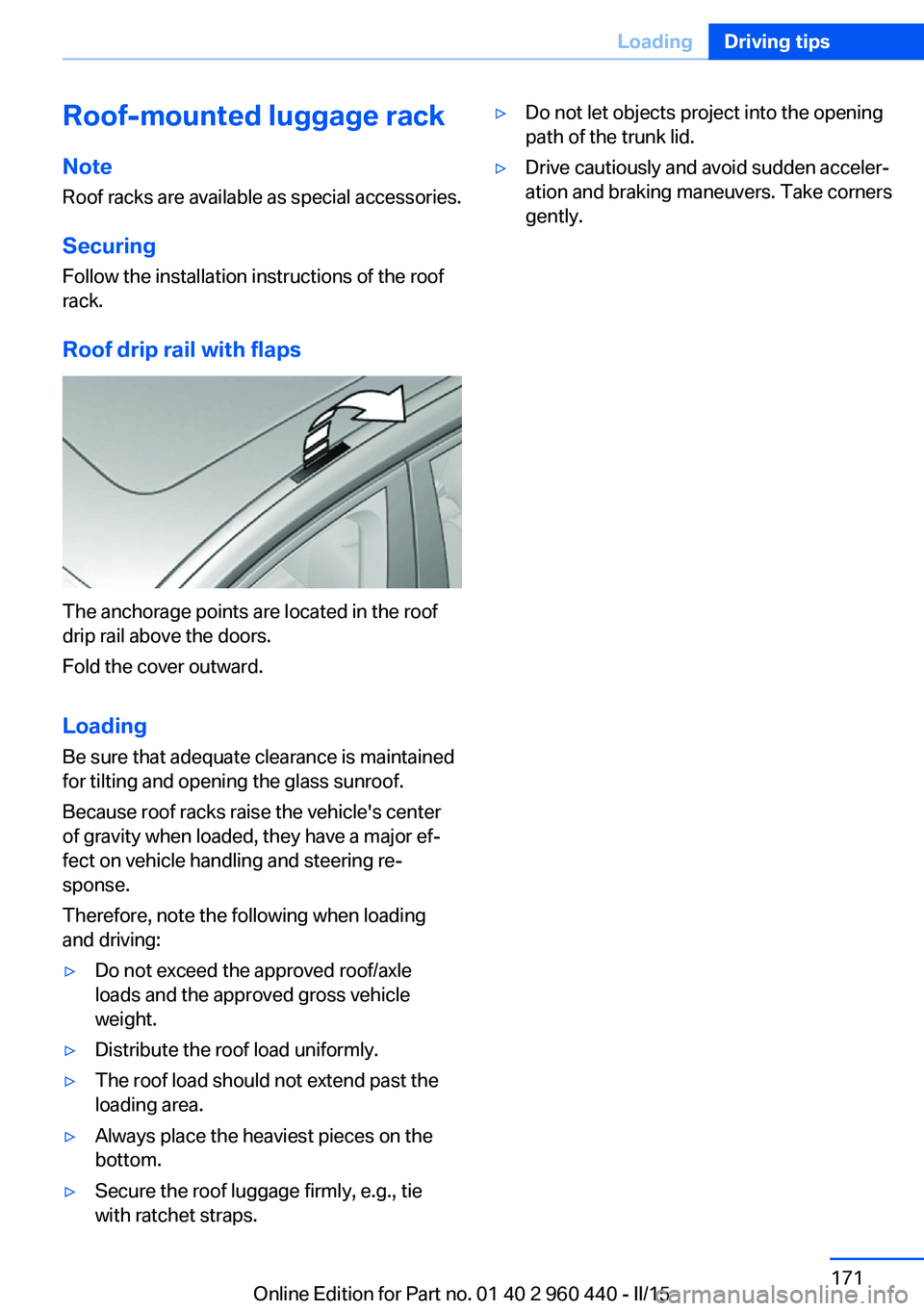
Roof-mounted luggage rackNoteRoof racks are available as special accessories.
Securing Follow the installation instructions of the roof
rack.
Roof drip rail with flaps
The anchorage points are located in the roof
drip rail above the doors.
Fold the cover outward.
Loading Be sure that adequate clearance is maintained
for tilting and opening the glass sunroof.
Because roof racks raise the vehicle's center
of gravity when loaded, they have a major ef‐
fect on vehicle handling and steering re‐
sponse.
Therefore, note the following when loading
and driving:
▷Do not exceed the approved roof/axle
loads and the approved gross vehicle
weight.▷Distribute the roof load uniformly.▷The roof load should not extend past the
loading area.▷Always place the heaviest pieces on the
bottom.▷Secure the roof luggage firmly, e.g., tie
with ratchet straps.▷Do not let objects project into the opening
path of the trunk lid.▷Drive cautiously and avoid sudden acceler‐
ation and braking maneuvers. Take corners
gently.Seite 171LoadingDriving tips171
Online Edition for Part no. 01 40 2 960 440 - II/15
Page 176 of 257
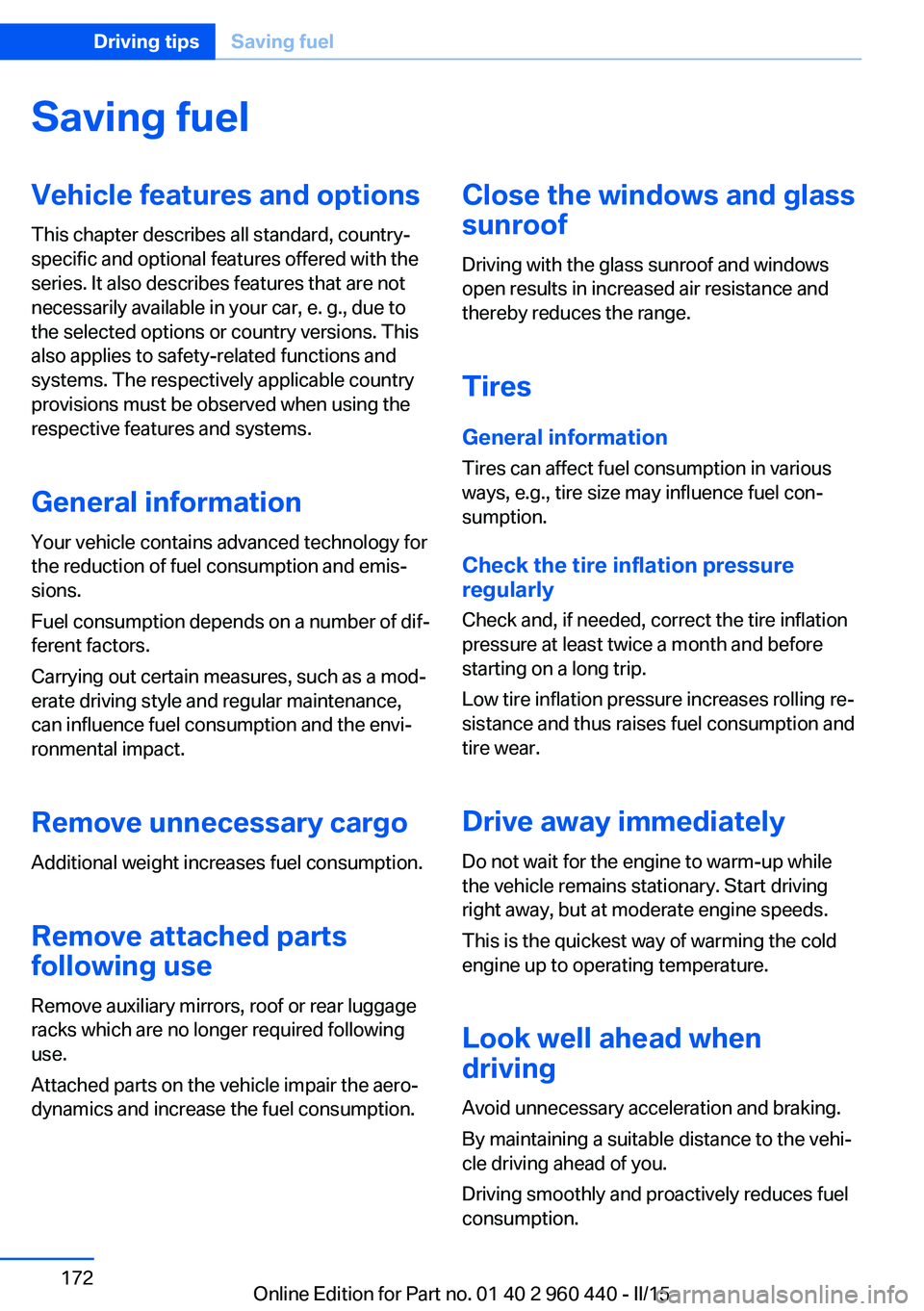
Saving fuelVehicle features and optionsThis chapter describes all standard, country-
specific and optional features offered with the
series. It also describes features that are not
necessarily available in your car, e. g., due to
the selected options or country versions. This
also applies to safety-related functions and
systems. The respectively applicable country
provisions must be observed when using the
respective features and systems.
General information Your vehicle contains advanced technology for
the reduction of fuel consumption and emis‐
sions.
Fuel consumption depends on a number of dif‐
ferent factors.
Carrying out certain measures, such as a mod‐
erate driving style and regular maintenance,
can influence fuel consumption and the envi‐
ronmental impact.
Remove unnecessary cargo
Additional weight increases fuel consumption.
Remove attached parts
following use
Remove auxiliary mirrors, roof or rear luggage
racks which are no longer required following use.
Attached parts on the vehicle impair the aero‐
dynamics and increase the fuel consumption.Close the windows and glass
sunroof
Driving with the glass sunroof and windows
open results in increased air resistance and
thereby reduces the range.
Tires
General information Tires can affect fuel consumption in various
ways, e.g., tire size may influence fuel con‐
sumption.
Check the tire inflation pressure
regularly
Check and, if needed, correct the tire inflation
pressure at least twice a month and before
starting on a long trip.
Low tire inflation pressure increases rolling re‐
sistance and thus raises fuel consumption and
tire wear.
Drive away immediately
Do not wait for the engine to warm-up while
the vehicle remains stationary. Start driving
right away, but at moderate engine speeds.
This is the quickest way of warming the cold
engine up to operating temperature.
Look well ahead when
driving
Avoid unnecessary acceleration and braking.
By maintaining a suitable distance to the vehi‐
cle driving ahead of you.
Driving smoothly and proactively reduces fuel
consumption.Seite 172Driving tipsSaving fuel172
Online Edition for Part no. 01 40 2 960 440 - II/15
Page 225 of 257
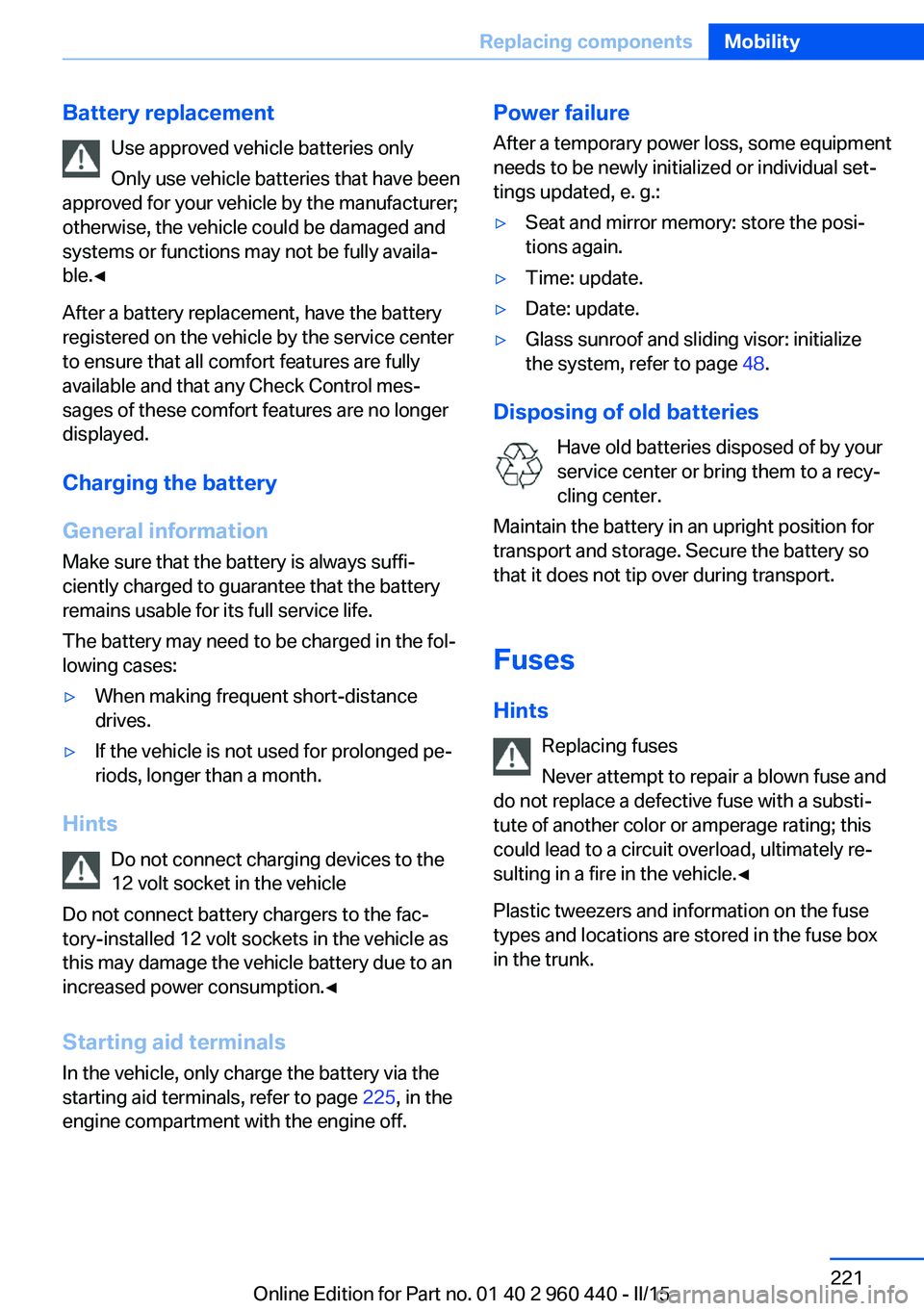
Battery replacementUse approved vehicle batteries only
Only use vehicle batteries that have been
approved for your vehicle by the manufacturer;
otherwise, the vehicle could be damaged and
systems or functions may not be fully availa‐
ble.◀
After a battery replacement, have the battery registered on the vehicle by the service center
to ensure that all comfort features are fully
available and that any Check Control mes‐
sages of these comfort features are no longer
displayed.
Charging the battery
General information Make sure that the battery is always suffi‐
ciently charged to guarantee that the battery
remains usable for its full service life.
The battery may need to be charged in the fol‐
lowing cases:▷When making frequent short-distance
drives.▷If the vehicle is not used for prolonged pe‐
riods, longer than a month.
Hints
Do not connect charging devices to the
12 volt socket in the vehicle
Do not connect battery chargers to the fac‐
tory-installed 12 volt sockets in the vehicle as
this may damage the vehicle battery due to an
increased power consumption.◀
Starting aid terminals
In the vehicle, only charge the battery via the
starting aid terminals, refer to page 225, in the
engine compartment with the engine off.
Power failure
After a temporary power loss, some equipment
needs to be newly initialized or individual set‐
tings updated, e. g.:▷Seat and mirror memory: store the posi‐
tions again.▷Time: update.▷Date: update.▷Glass sunroof and sliding visor: initialize
the system, refer to page 48.
Disposing of old batteries
Have old batteries disposed of by your
service center or bring them to a recy‐
cling center.
Maintain the battery in an upright position for
transport and storage. Secure the battery so
that it does not tip over during transport.
Fuses Hints Replacing fuses
Never attempt to repair a blown fuse and
do not replace a defective fuse with a substi‐
tute of another color or amperage rating; this
could lead to a circuit overload, ultimately re‐
sulting in a fire in the vehicle.◀
Plastic tweezers and information on the fuse
types and locations are stored in the fuse box
in the trunk.
Seite 221Replacing componentsMobility221
Online Edition for Part no. 01 40 2 960 440 - II/15
Page 233 of 257

CareVehicle features and optionsThis chapter describes all standard, country-
specific and optional features offered with the
series. It also describes features that are not
necessarily available in your car, e. g., due to
the selected options or country versions. This
also applies to safety-related functions and
systems. The respectively applicable country
provisions must be observed when using the
respective features and systems.
Car washes General information
Regularly remove foreign objects such as
leaves in the area below the windshield when
the hood is raised.
Wash your vehicle frequently, particularly in
winter. Intense soiling and road salt can dam‐
age the vehicle.
Hints Steam jets or high-pressure washers
When using steam jets or high-pressure
washers, hold them a sufficient distance away
and use a maximum temperature of
140 ℉/60 ℃.
If the vehicle has a glass sunroof, ensure that a
distance of at least 31.5 inches/80 cm is main‐
tained. Holding them too close or using exces‐
sively high pressures or temperatures can
cause damage or preliminary damage that may
then lead to long-term damage.
Follow the user's manual for the high-pressure
washer.◀Cleaning sensors/camera lenses with
high-pressure washers
When using high-pressure washers, do not
spray the sensors and camera lenses on the
outside of the vehicle for long periods and
maintain a distance of at least 12 in/30 cm.◀
Automatic car washes
Hints▷Give preference to cloth car washes or
those that use soft brushes in order to
avoid paint damage.▷Make sure that the wheels and tires are not
damaged by the transport mechanisms.▷Fold in the exterior mirrors; otherwise, they
may be damaged, depending on the width
of the vehicle.▷Deactivate the rain sensor, refer to
page 70, to avoid unintentional wiper acti‐
vation.▷In some cases, an unintentional alarm can
be triggered by the interior motion sensor
of the alarm system. Follow the instruc‐
tions on avoiding an unintentional alarm,
refer to page 45.
Guide rails in car washes
Avoid car washes with guide rails higher
than 4 in/10 cm; otherwise, the vehicle body
could be damaged.◀
Before driving into a car wash In order to ensure that the vehicle can roll in a
car wash, take the following steps:
Manual transmission:
1.Drive into the car wash.2.Shift to neutral.Seite 229CareMobility229
Online Edition for Part no. 01 40 2 960 440 - II/15
Page 249 of 257
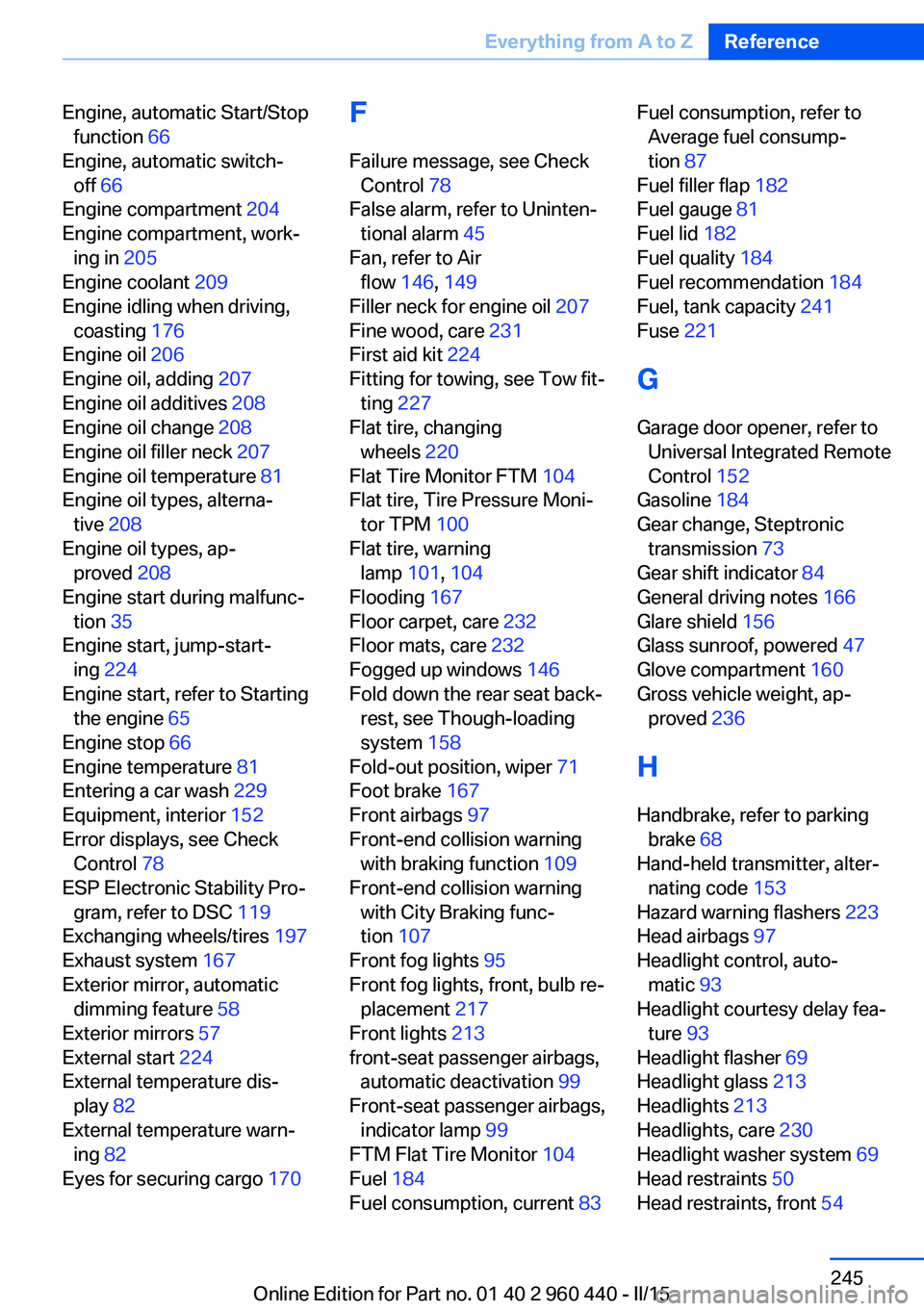
Engine, automatic Start/Stopfunction 66
Engine, automatic switch- off 66
Engine compartment 204
Engine compartment, work‐ ing in 205
Engine coolant 209
Engine idling when driving, coasting 176
Engine oil 206
Engine oil, adding 207
Engine oil additives 208
Engine oil change 208
Engine oil filler neck 207
Engine oil temperature 81
Engine oil types, alterna‐ tive 208
Engine oil types, ap‐ proved 208
Engine start during malfunc‐ tion 35
Engine start, jump-start‐ ing 224
Engine start, refer to Starting the engine 65
Engine stop 66
Engine temperature 81
Entering a car wash 229
Equipment, interior 152
Error displays, see Check Control 78
ESP Electronic Stability Pro‐ gram, refer to DSC 119
Exchanging wheels/tires 197
Exhaust system 167
Exterior mirror, automatic dimming feature 58
Exterior mirrors 57
External start 224
External temperature dis‐ play 82
External temperature warn‐ ing 82
Eyes for securing cargo 170 F
Failure message, see Check Control 78
False alarm, refer to Uninten‐ tional alarm 45
Fan, refer to Air flow 146, 149
Filler neck for engine oil 207
Fine wood, care 231
First aid kit 224
Fitting for towing, see Tow fit‐ ting 227
Flat tire, changing wheels 220
Flat Tire Monitor FTM 104
Flat tire, Tire Pressure Moni‐ tor TPM 100
Flat tire, warning lamp 101, 104
Flooding 167
Floor carpet, care 232
Floor mats, care 232
Fogged up windows 146
Fold down the rear seat back‐ rest, see Though-loading
system 158
Fold-out position, wiper 71
Foot brake 167
Front airbags 97
Front-end collision warning with braking function 109
Front-end collision warning with City Braking func‐
tion 107
Front fog lights 95
Front fog lights, front, bulb re‐ placement 217
Front lights 213
front-seat passenger airbags, automatic deactivation 99
Front-seat passenger airbags, indicator lamp 99
FTM Flat Tire Monitor 104
Fuel 184
Fuel consumption, current 83 Fuel consumption, refer to
Average fuel consump‐
tion 87
Fuel filler flap 182
Fuel gauge 81
Fuel lid 182
Fuel quality 184
Fuel recommendation 184
Fuel, tank capacity 241
Fuse 221
G Garage door opener, refer to Universal Integrated Remote
Control 152
Gasoline 184
Gear change, Steptronic transmission 73
Gear shift indicator 84
General driving notes 166
Glare shield 156
Glass sunroof, powered 47
Glove compartment 160
Gross vehicle weight, ap‐ proved 236
H Handbrake, refer to parking brake 68
Hand-held transmitter, alter‐ nating code 153
Hazard warning flashers 223
Head airbags 97
Headlight control, auto‐ matic 93
Headlight courtesy delay fea‐ ture 93
Headlight flasher 69
Headlight glass 213
Headlights 213
Headlights, care 230
Headlight washer system 69
Head restraints 50
Head restraints, front 54 Seite 245Everything from A to ZReference245
Online Edition for Part no. 01 40 2 960 440 - II/15
Page 252 of 257
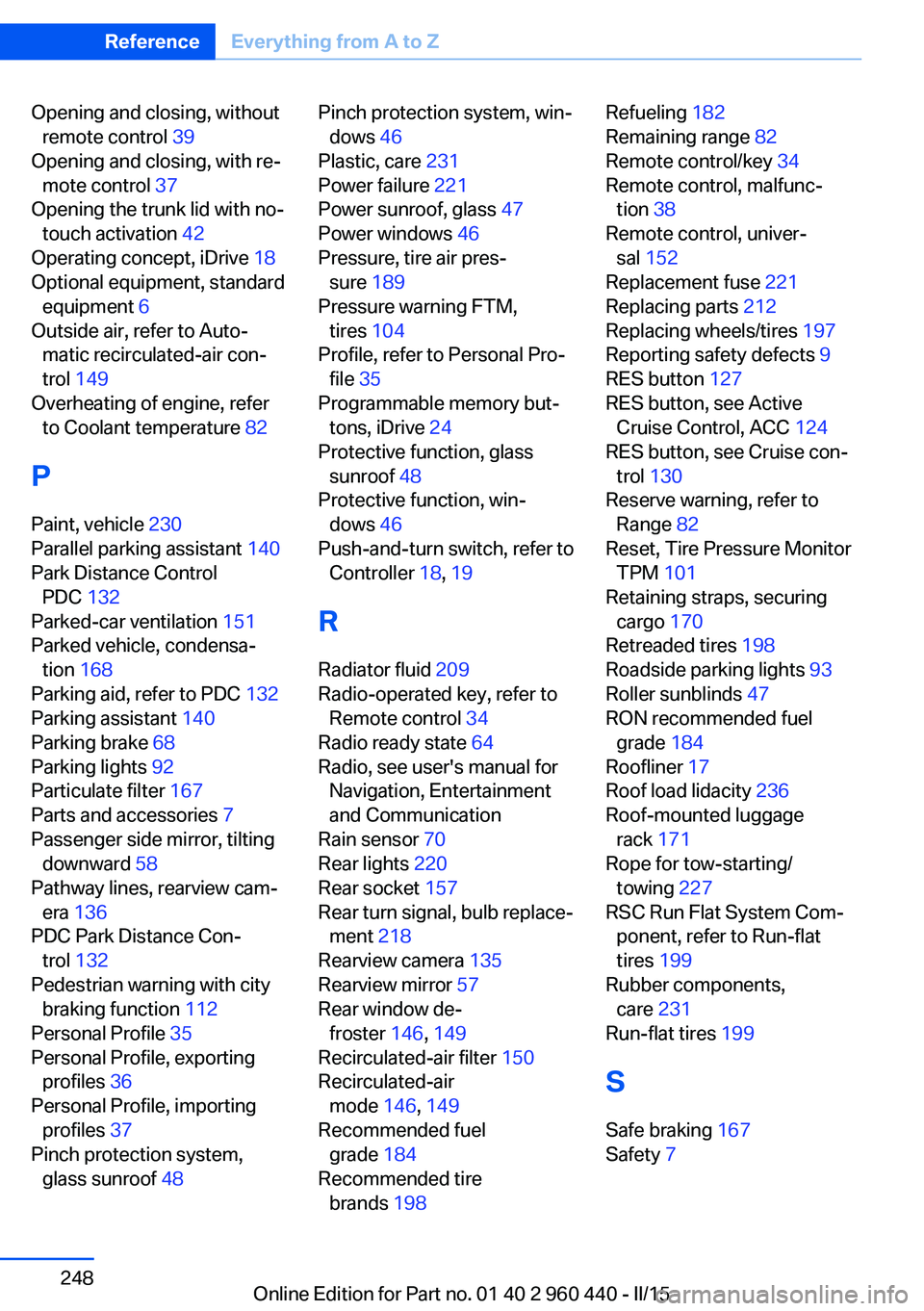
Opening and closing, withoutremote control 39
Opening and closing, with re‐ mote control 37
Opening the trunk lid with no- touch activation 42
Operating concept, iDrive 18
Optional equipment, standard equipment 6
Outside air, refer to Auto‐ matic recirculated-air con‐
trol 149
Overheating of engine, refer to Coolant temperature 82
P Paint, vehicle 230
Parallel parking assistant 140
Park Distance Control PDC 132
Parked-car ventilation 151
Parked vehicle, condensa‐ tion 168
Parking aid, refer to PDC 132
Parking assistant 140
Parking brake 68
Parking lights 92
Particulate filter 167
Parts and accessories 7
Passenger side mirror, tilting downward 58
Pathway lines, rearview cam‐ era 136
PDC Park Distance Con‐ trol 132
Pedestrian warning with city braking function 112
Personal Profile 35
Personal Profile, exporting profiles 36
Personal Profile, importing profiles 37
Pinch protection system, glass sunroof 48 Pinch protection system, win‐
dows 46
Plastic, care 231
Power failure 221
Power sunroof, glass 47
Power windows 46
Pressure, tire air pres‐ sure 189
Pressure warning FTM, tires 104
Profile, refer to Personal Pro‐ file 35
Programmable memory but‐ tons, iDrive 24
Protective function, glass sunroof 48
Protective function, win‐ dows 46
Push-and-turn switch, refer to Controller 18, 19
R Radiator fluid 209
Radio-operated key, refer to Remote control 34
Radio ready state 64
Radio, see user's manual for Navigation, Entertainment
and Communication
Rain sensor 70
Rear lights 220
Rear socket 157
Rear turn signal, bulb replace‐ ment 218
Rearview camera 135
Rearview mirror 57
Rear window de‐ froster 146, 149
Recirculated-air filter 150
Recirculated-air mode 146, 149
Recommended fuel grade 184
Recommended tire brands 198 Refueling 182
Remaining range 82
Remote control/key 34
Remote control, malfunc‐ tion 38
Remote control, univer‐ sal 152
Replacement fuse 221
Replacing parts 212
Replacing wheels/tires 197
Reporting safety defects 9
RES button 127
RES button, see Active Cruise Control, ACC 124
RES button, see Cruise con‐ trol 130
Reserve warning, refer to Range 82
Reset, Tire Pressure Monitor TPM 101
Retaining straps, securing cargo 170
Retreaded tires 198
Roadside parking lights 93
Roller sunblinds 47
RON recommended fuel grade 184
Roofliner 17
Roof load lidacity 236
Roof-mounted luggage rack 171
Rope for tow-starting/ towing 227
RSC Run Flat System Com‐ ponent, refer to Run-flat
tires 199
Rubber components, care 231
Run-flat tires 199
S Safe braking 167
Safety 7 Seite 248ReferenceEverything from A to Z248
Online Edition for Part no. 01 40 2 960 440 - II/15